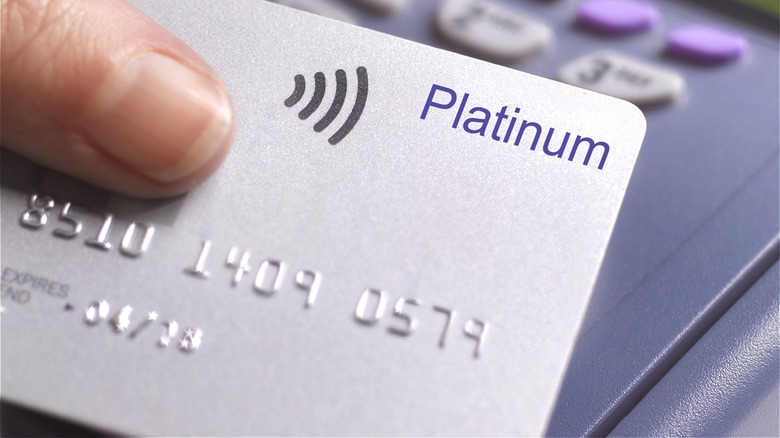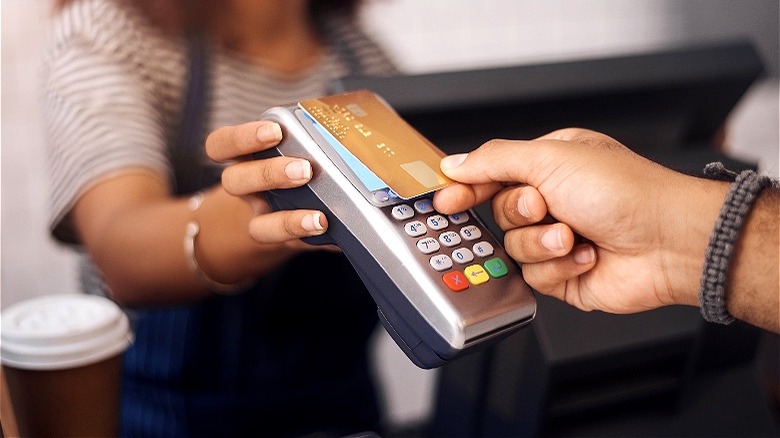Here's What The Wi-Fi Logo On Your Credit Card Actually Means
Contactless payment may have grown popular as a way to avoid germs in the midst of the COVID-19 pandemic, but it's clear this technology is here to stay. For example, back in 2020, a Mastercard study found that 74% of the consumers surveyed said they would continue using contactless payment going forward. Further, again according to Mastercard, 51% of Americans in 2021 were already using some form of contactless payment (via Next Gen Personal Finance).
Sure, there's mobile wallets for your smartphone or smart watch, like Apple Wallet, that can store payment methods for contactless payment. But for the less technologically inclined among us, many old-school, garden-variety credit cards are contactless also, and you might not even realize it. The quickest way to tell is to look for a symbol showing a series of curved lines that's similar to the logo for Wi-Fi wireless networking (by the way, how much should you pay for high-speed internet?). Technically, that Wi-Fi symbol is called the EMVCo Contactless Indicator.
If your credit card has the Wi-Fi symbol, then you're eligible to pay for purchases just by tapping your card on compatible payment terminals. Note that in some cases, the contactless feature will be built into a traditional card reader while others will have a separate wireless reader. Note, not every merchant has a contactless payment terminal yet, but as an example, about 80% of businesses that accept Visa cards are contactless-equipped, per Visa.
How to use a contactless credit card
If your favorite credit card isn't contactless, it's worth reaching out to the card's issuer to inquire if a more recent version of the card, with the contactless feature, is offered. Be aware, though, that not all cards are available in contactless form yet. As well, if you receive a new physical credit card, you'll need to edit the card number and its other credentials if it's being used to make automatic payments.
To use a contactless credit card, just tap or briefly hold the card where indicated on the card reader. Sometimes this area of the card reader is marked with the same Wi-Fi symbol as the contactless card itself. Your card needs to be quite close to the reader — 1 or 2 inches at most — to avoid accidentally detecting the card from further distances. For example, inadvertently paying for another shopper's purchase.
Finally, if you have more than one contactless card in your wallet, you will want to remove the selected card from the wallet for tapping rather than tapping the entire wallet. Tapping a wallet with multiple contactless cards could charge the wrong card by accident. Once your credit card has been successfully read, you'll receive a confirmation via a beep, flashing lights, or perhaps both. If you have accidentally tapped your card twice, don't worry. You'll only be charged once.
Contactless payment is convenient for thieves, too
Besides the Wi-Fi symbol, you might also be wondering about the reflective silver square that's present on so many credit cards nowadays. It's actually an embedded microchip to prevent fraud. So-called chip cards or smart cards are considered more secure than traditional cards because they're more difficult to skim. The technology has been popular in the United States for about 10 years.
Contactless payment actually works quite similarly to chip credit cards, without need to actually insert the card into a slot to read the chip. Both chip and contactless methods create a one-time code for each transaction, accompanied by your credit card number. Note that no personal information like your name, address, or the card's card verification value (or CVV) code is shared during the process.
As for the downside to contactless payment, if there is one, it's the ease-of-use for criminals if the physical card is stolen. There's no PIN number or signature required to make a contactless payment. Of course, credit card companies have fraud protection that also covers such theft, so you won't be responsible for fraudulent charges if your card is stolen. With this said, because of this ease-of-use to thieves, some banks and card issuers limit the maximum dollar value of contactless transactions to reduce their exposure to liability. For example, American Express has a $250 limit for contactless transactions. You can still use your card for larger purchases, but not in contactless mode.


